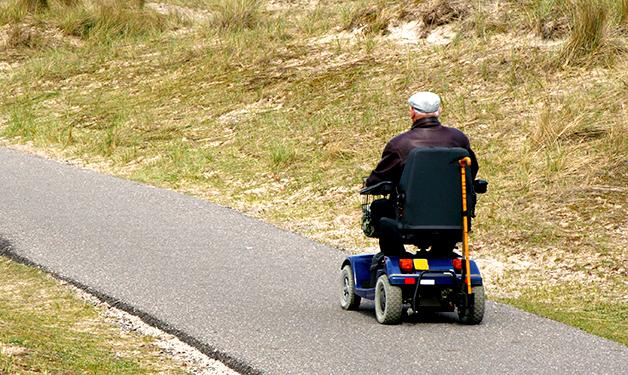
ScanCourse test reliability leads to increased powered-mobility safety.
Vancouver Coastal Health Research Institute scientist Dr. Ben Mortenson chuckles when he says that human beings are not great at doing two things at once or switching from one task to another. He and colleague Lisa Kristalovich at the GF Strong Rehabilitation Centre have worked together for five years on a number of research projects looking at the dual-task of driving, particularly among individuals with neurological impairments. Their paper, published in The American Journal of Occupational Therapy, assessed the reliability of ScanCourse—a test meant to measure an individual’s dual-tasking ability.
ScanCourse is used in occupational therapy settings as part of the Brain Injury Visual Assessment Battery for Adults to assess how well a person can visually scan their surroundings while in motion and moving from one place to another. It is used clinically when assessing potential to use powered mobility, such as powered wheelchairs, or to drive a car.
“If someone is having problems performing activities that require visual scanning while in motion, this test can help determine the basis of those problems,” explains Mortenson, an associate professor in the Department of Occupational Science and Occupational Therapy in the Faculty of Medicine at the University of British Columbia. “For example, if an individual is using a 300 lb power wheelchair and isn’t attending well to their environment, that’s a concern.”
“Using ScanCourse to figure out what’s going on for an individual in terms of their ability to attend to their environment allows us to better tailor interventions that can ultimately improve their task-switching skills, safety and mobility.”

ScanCourse involves numbers being placed on the walls of either side of a hallway. The person being assessed moves down the hallway and has to identify out loud the numbers on the walls as they move along.
“You have to move yourself either in a wheelchair or by walking, but you also have to pay attention to things on your sides, much as you would if you were driving,” says Mortenson.
For their study, Mortenson and his colleagues enlisted occupational therapists to administer ScanCourse to 41 patients with neurological impairments. Results of the study found that ScanCourse had strong measurement properties and is an appropriate tool for assessing dual-task visual scanning among individuals with neurological issues. The researchers’ study offers the first evaluation of the ScanCourse’s validity and reliability since its development in 1999.
“When examining the measurement properties of an instrument, we look at reliability in terms of whether or not you get the same results over time,” says Mortensen. “We found that ScanCourse’s reliability was extremely high. Additionally, we also found it was significantly correlated to other highly reliable tests of visual attention and task-switching.”
“Clinicians using ScanCourse to assess clients can feel confident that the results are reliable and valid.”
ScanCourse standardization guidelines made widely available
Realizing that ScanCourse comes with outdated and limited instructions in terms of how the test should be administered, Mortenson and his colleagues worked with students and clinicians to standardize the assessment and develop a new testing manual.
“We developed a manual to ensure that anyone using ScanCourse is consistently using the same size numbers, font, level of contrast and things of that nature,” says Mortenson. “For our study, we worked with people from a number of sites and the idea was that all of these sites that were collecting data for us would use the same set of directions.”
The team has made the manual freely available and is encouraging anyone using ScanCourse to use it.


